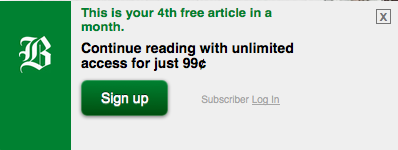I travel a lot, and buy newspapers wherever I happen to be. That would be true online as well, if I could do it. But I can’t, because that’s not an option.
For example, my butt is in California right now, but my nose is in Boston, where I’m reading the Globe. I don’t want a subscription to the Globe, but I would like to pay for today’s paper, or for at least the right to read a few stories from it.
Not easy. Or even possible, after the first one or two. Because, soon enough this paywall thingie comes up:

It’ a subscription come-on, modeled after the one the New York Times has been using for years, and I wrote about back in 2012, here. (The switch after the above bait: “$.99*… *That’s less than $1 for 4 full weeks! Then pay the regular low rate of $3.99 per week.”)
I had some advice for the Times at that last link, and I’ve got some for all papers today: create an à la carte option. I know there are lots of reasons not to, all of which arise from system-based considerations on the sell side of the relationship with newspaper buyers.
What I’m saying is that the newsstand option has worked fine for more than a century in the physical world, and should be an option in the networked one as well.
At least think about it. Constructively, as in Let’s see… how can we do that? Not “It’s too hard.” Or “People only want free stuff.” Those are all echoes inside the old box. I want us to think and work outside of that box.
People are willing to pay value for value if it’s easy. So let’s make it easy. The ideas I vetted three years ago are still good, but don’t cover the à la carte option. Let’s just focus on that one, and consider what’s possible.
Leave a Reply